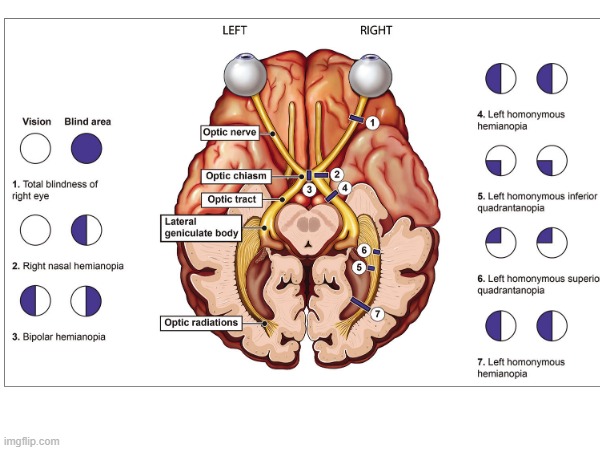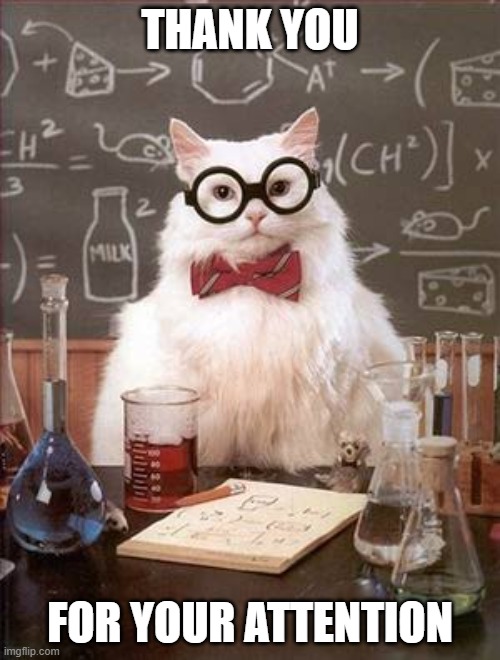Braaaiiinnnnssss
2952
76
1

Welcome to another edition of neurology teaching. Today let's learn a little about how our brains process information from our eyes into the complex special sense many of us experience as vision!
I am a neurology resident, and I love teaching my patients, colleagues and friends about how the brain works.

Let's start with the basics:
You may have vague memories from science class that the RIGHT side of the brain controls the LEFT side of the body?
The same is true for vision processing. The RIGHT side of the brain perceives the LEFT side of the world, or your left visual field.
Confusingly, BOTH eyes have a left visual field and both eyes have a right visual field.
So, the RIGHT side of the brain processes information from both eyes.
Sometimes, when people have a brain problem that results in loss of, say, the left visual field, they will mistakenly think it is their left eye that's the problem. However, they will notice if they close the left eye, they will still be unable to see the left half of the visual field perceived by the right eye.

Okay, so it gets kinda complicated.
After our eyeballs (retina) are stimulated by light in our environment, signals get sent back via several nerves to brain.
1. Optic nerves: one for each eye. These contain information from its respective eyeball, which has data from both the right and left side of the visual field.
2. Optic chiasm: the interchange of optic nerves, where data gets sorted into left and right visual fields.
3. Lateral geniculate nucleus: first major stop and synapse for the optic pathways. This is in the brain's major relay center, the thalamus. Some processing happens here, but it's very basic.
4. Optic radiations (not labeled): the path that the nerves takes to go from the LGN to the occipital lobe. These run through the parietal and temporal lobes. The lower part of that visual hemifield goes through the upper (parietal) pathway, and the upper part of the visual hemifield goes through the lower (temporal) pathway.
5. Primary visual cortex: location of fundamental visual processing in the brain

What happens to your vision if these fundamental parts of vision are damaged?
1. Optic nerve-- blindness in that eye
2. Optic chiasm-- loss of peripheral vision (bitemporal or bipolar hemianopia)
3. Optic radiation-- loss of a quadrant of visual field (quadrananopia)
4. Primary visual cortex-- loss of visual field (homonymous hemianopia)

Now let's get into the more unusual disorders of vision processing.
What happens when you have damage to BOTH primary visual cortexes (left and right side)?
You get cortical blindness, meaning the eyes and the optic nerves are just fine, but the brain can no longer interpret this information. People with these lesions are essentially completely blind.
BUT.. in some cases (because the brain is very strange) the person affected by this may be entirely unaware of their vision loss. When people who have cortical blindness deny that they are blind and unintentionally make up (or confabulate) stories about what they are "seeing", this is called "Anton syndrome". It is a form of "anosognosia", or lack of insight into a deficit. This comes up with lesions to other parts of the brain too.

Do not say this 10 times fast.
In visual apperceptive agnosia, lesions to the occipital (visual) lobes cause marked impairment in vision, but rather than causing loss of light perception, this problem is prominently in ability to recognize objects.
People that suffer from this can navigate and avoid objects in a room, but cannot recognize objects presented to them, match things, or point to things that are named. Sometimes still objects are perceived as invisible until they move. Interestingly, visual acuity and visual field testing is typically normal.

Some people suck at remembering faces (guilty party right here). Some people have brain lesions that impair their ability to recognize faces.
Prosopagnosia is the inability to recognize faces. This is a disorder of visual processing which typically occurs after a lesion to the (usually bilateral) fusiform gyrus (temporal lobe). It can be severe enough that they cannot recognize themselves in the mirror or family members in person or via photos. People affected by this can typically identify that a face is a face, or parts of faces, but fail to ascribe correct meaning to them.
Beyond faces, people who suffer from this impairment also often have great difficulty picking out an object from a group of similar objects (cars in a parking lot, cows in a herd).
Shameless plug for Oliver Sacks book above. Lots of great interesting neurology stories, written accessibly for lay readers.

Landmark agnosia, which typically occurs due to an isolated lesion to the right ligual sulcus in the parahippocampal place area, results in an inability to navigate familiar environments due to loss of ability to recognize familiar landmarks.

People that suffer bilateral parietal-occipital lobe lesions may experience simultagnosia.
This is the inability to perceive simultaneously presented visual stimuli. It makes understanding visual input beyond basic, singly presented objects incredibly difficult. For example, looking at a picture of a group of friends at a beach, the affected person may see sky. When something else it pointed at they may see sand. They do not perceive the whole picture.
This can also occur with other symptoms as part of what is known as "Balint syndrome". This includes:
1. Simultagnosia
2. Ocular apraxia-- inability or difficulty voluntarily shifting ones gaze between objects or redirecting visual attention.
3. Optic ataxia-- difficulty reaching for things that are seen

Thank you for following along and letting me share my love of neurology with all of you!
YsgramorsSoupSpoon
ScarecrowSticks
KnifeKnut
Does Prosopagnosia also cause problems counting identical (or nearly so) objects, as I suspect it does?
Braaaiiinnnnssss
I'm not sure. I imagine it would, as it would be difficult to be sure which one you've already counted. Good question
snappysnaps
Quite interesting, thanks
ZebAsiz
I've learned something today. Thank you! =D
Mxlespxles
Flortzweich
I just went through GBS and still recovering from the lingering bilateral facial palsy and double vision as one eye won't move correctly
RowanUnderwood
Jaron Lanier (Father of VR) has Prosopagnosia.
kaeldra
As an optometry nerd I fucking loved this post. Thanks @op
StevesAPunk